- Created by Werkstatt, last modified by Tobias Kaupat on Sept 24, 2024
The Lobaro Maintenance Tool can be used to configure and diagnose Lobaro IoT devices locally using a PC and a special USB configuration adapter.
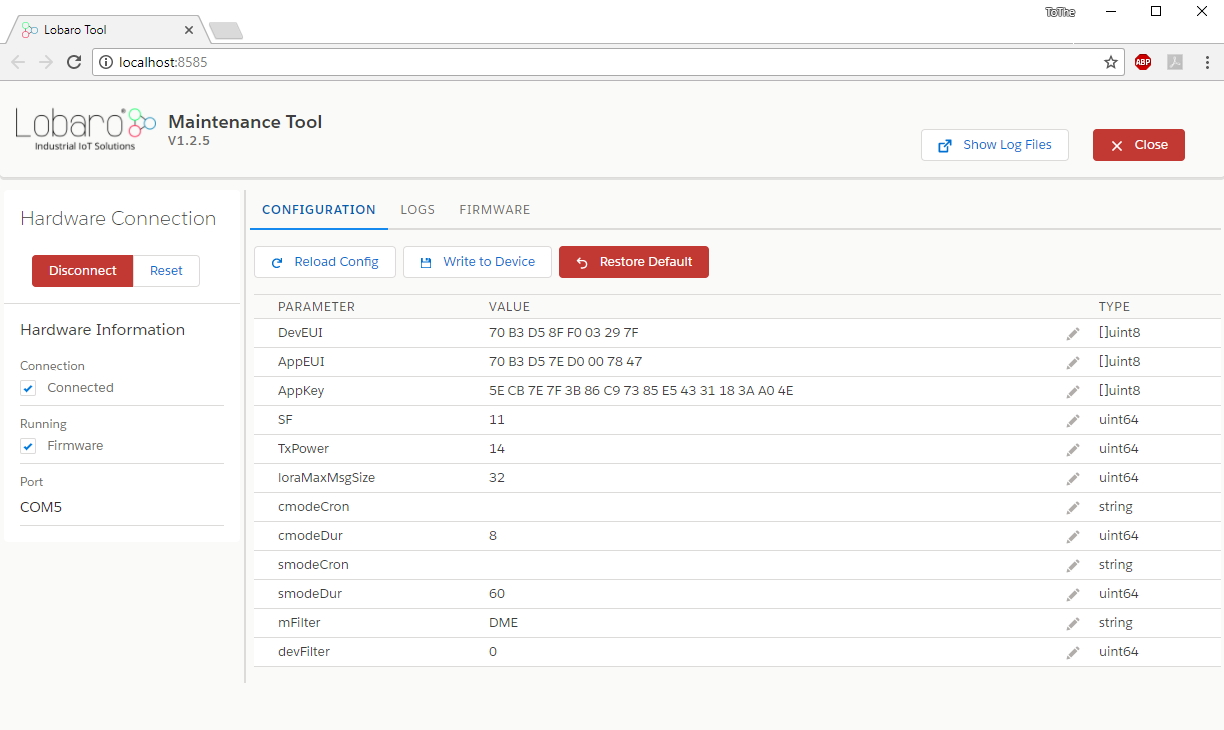
Downloads
- Lobaro Maintenance Tool Download (v2.2.0 Windows)
- Lobaro Maintenance Tool Download (v2.2.0 Linux)
- Lobaro Maintenance Tool Download (v2.2.0 Mac 64Bit)
- Lobaro Maintenance Tool all versions
- CP2102 Driver Download Choose:
- CP210x Windows Drivers v6.7.6 for Windows 7-8.1,
- CP210x_Universal_Windows_Driver for Windows 10 and later
Device config not saved?
When upgrading the Lobaro Tool from version v1.4.x or earlier you have to hit "F5" or "Site full reload" in your browser once the Lobaro Tool started!
Otherwise your device config can not be saved! This is because your browser caches the incompatible frontend from earlier versions.
Supports the PC based configuration of all Lobaro IoT sensors.
It is intended to be used in conjunction with our USB configuration adapter.
Features
- Change static sensor configuration
- Perform firmware updates for your Lobaro devices
- Live monitoring of device diagnostic output
- Save diagnostic output into *.txt file
System Requirements
Operating system:
- MacOS X
- Windows 7/10
- Linux
Browser
- Firefox
- Chrome
- Edge
USB Driver
The CP2102 USB driver MUST to be installed before using the Lobaro-tool.
(Choose CP210x Windows Drivers v6.7.6 for Windows 10, CP210x_Universal_Windows_Driver.zip for Windows 11)
Download & Installation
macOS / Linux
After downloading the "lobaro-tool" file, e.g. to a directory "lobaro" in your home path. Then make the tool file executable:
cd ~/lobaro
chmod +x lobaro-tool
./lobaro-tool
Info
If MacOS shows up a security warning and refuses to start the tool: You can solve this by right-clicking the lobaro-tool file, selecting open and overrule the warning.
Windows
After downloading simply start the "lobaro-tool.exe" with double click.
Alternativly download the windows installer and start this.
Note
Windows might show up a security warning and ask you to proceed anyway. This behavior is normal.
Physical connection
Connect your Lobaro Device to the USB-port of your computer using the Lobaro Config Adapter. The 6-pin connector must be plugged into the white rectangular socket on the device that is labeled with the word CONFIG. The location of the socket is dependent on the specific device and hardware version you are trying to attach.
Make sure to use the port labeled CONFIG
Some of our devices have multiple sockets the connector fits into. Be sure to use the correct one, the one labeled CONFIG!
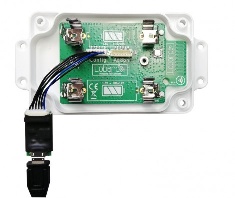
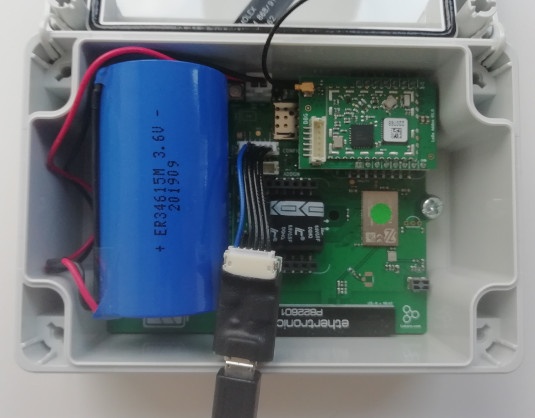
The LoRaWAN Board (left image) can be powered by the config adapter. Other devices, like the NB-IoT/LTE-M boards or the wMBus LoRaWAN Bridge V2, need to be connected to their normal power supply. If in doubt, just make sure you have the device powered!
Software connection
When your device is successfully attached to your computer, you can build a connection with the Lobaro Maintenance Tool:
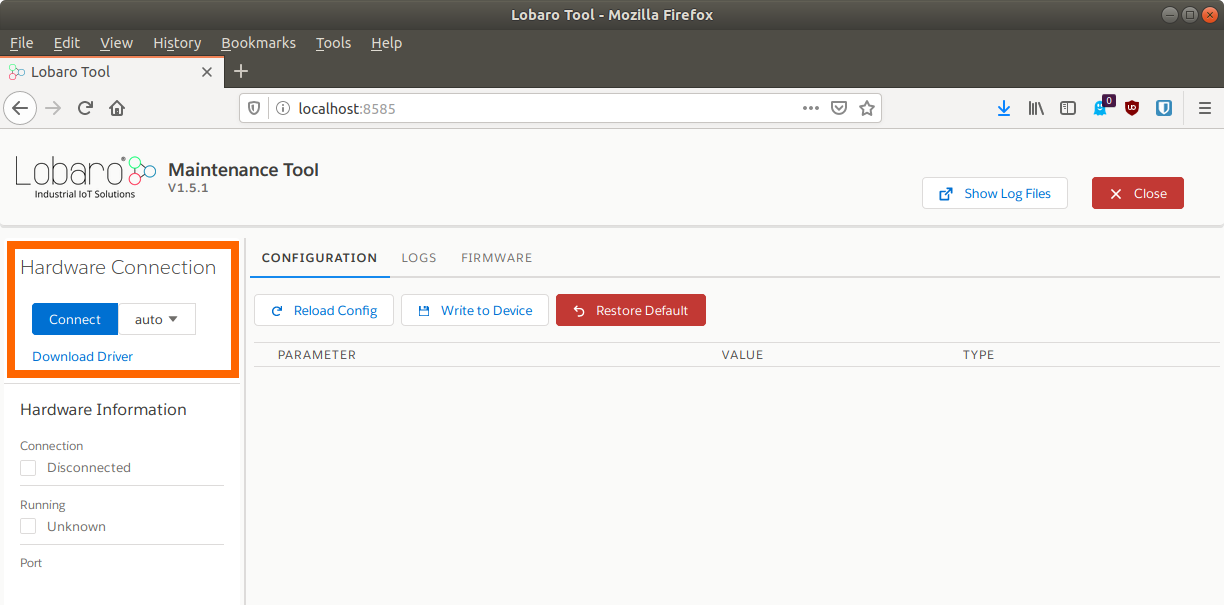
Under Hardware Connection select auto and click Connect, as seen in the screenshot above. If you know to which port the device is connected to your computer (either COM or ttyUSB), you can alternatively select it explicitly instead of using auto.
UART Connection
115200 Baud - 8E1 (8 Databits, Even Parity, 1 Stopbit) DTR (Boot): enabled, RTS (Reset): disabled (for starting in firmware mode).
Device Configuration

When you are connected to a Lobaro Device, you can use the Tab CONFIGURATION to read and change the configuration parameters of the Device. You can read out the current configuration from the device by pressing the Reload Config button (reading takes a few seconds).
Reading/changing config reboots the device!
Every time you use one of the buttons Reload Config. Write to Device, or Restore Default, the connected device will be rebooted! Also keep in mind that the operations triggered by pressing the buttons include communication with the device over a serial bus and they will take a few seconds.
To avoid errors, please do not press those buttons repeatedly!
When the configuration is read, you can alter the parameters by clicking on the pencil icon on the right. Values that you changed will by printed in bold font. When you have adjusted all values you want to change, you must press Write to Device to actually change anything on the Device. Writing the values will reboot the device.
The Button Restore Default will reset all config parameters of the connected Device to their internal default values. The device will reboot, and the listed values of the configuration in the Lobaro Maintenance Tool well be updated.
Always reload the config before changing it!
When you are working with multiple devices, make sure that your always press Reload Config after attaching a new device before you start updating values. If you fail to do so, you might accidentally transfer values from the previously attached device to the newly connected. This is especially a problem when working with LoRaWAN sensors, as you will copy the DevEUI from one device to the other!
You can watch the rebooting of the Device and check the altered configuration parameters by locking in the LOGS Tab.
Device Logging
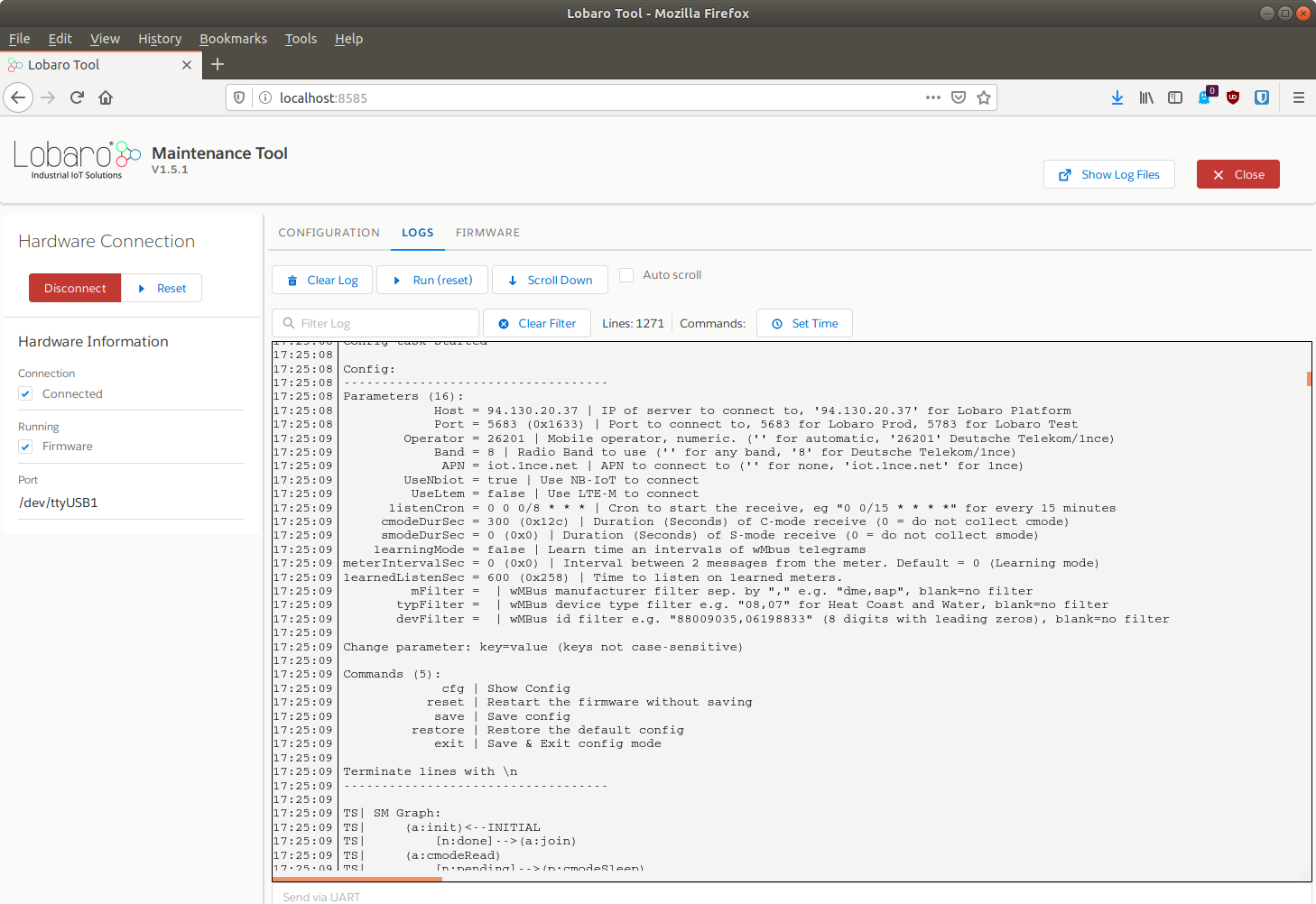
All of our Devices provide extensive logging information over the CONFIG port. When you are connected to a Device in the Lobaro Maintenance Tool, you can read the log messages in the LOGS Tab. This feature is helpful if you try to find out the cause of problems you experience. You can also find out a lot of information about your Device, for example you can find the parameters used to connect your LoRaWAN Devices to your Network Server (DevEUI, AppKey, etc.).
All messages are displayed in the big text area, each line is prefixed by the time it is received (using the clock of your computer). You can use Clear Log to start again with an empty text area. The cleared messages will still be available through the log files that the tool creates.
When starting, our devices print out their current configuration parameter values. Most Devices also have a power on test, that checks if attached sensors can be read successfully. Any Problems that the Device detects will be printed to the log.
Restarting
The LOGS Tab also contains a button Run (reset). This button triggers a reboot of the attached device. This can be useful when you start working with your device or if you try to fix issues with connected sensors.
Log files
The logs are also written to files on your computer. Every time you start the Lobaro Maintenance Tool, a new log file is created.
When you press the button Show Log Files, a file browser is opened at the location where log files are kept.

UART Logfiles are located at:
- Windows:
%homepath%\.lobaro\logs - Linux / Mac:
~/.lobaro/logs - File Name:
<DATE>-uart-log.txt
lobaro-tool.log.txt just contains the last lobaro-tool console output for debugging issues with the tool.
Sending to the Device
Below the text area is an input field Send via UART. Text entered here (and confirmed with Enter) will be sent to the connected Device via UART. Some of our Devices use this feature, for example the LoRaWAN Modbus Bridge for its interactive Dialog Mode.
Log parsing
If need to parse the log messages of one of our Devices with your own tools, you can connect to it without the Maintenance Tool by using any serial UART reader. You can find the UART parameters at the page for our Config Adapter.
Updating Firmware
Our devices are shipped ready to use with firmware installed on them, so normally you do not need to install firmware yourself. However, over time we sometimes add new features to our devices or fix bugs that come up over time. If you want to use those improvements for devices all ready shipped to you, you can update the firmware yourself.
Firmware updates with our config adapter vs. firmware update over the air (FUOTA)
This page describes how you install firmware on devices that you have physical access to. This can be done for most of our devices, those using LoRaWAN and those using NB-IoT/LTE-M.
Our NB-IoT/LTE-M devices also support installing firmware over the air, without physical access. This can currently only be done by Lobaro.
Getting the Firmware
You will need the Firmware you want to install to your device as a file on your computer. You can get the latest Firmware files from this site, the Lobaro Online Documentation, on the Firmware subpage for your Device. The files are in a format called Hex and are therefore also called Hex-File. The filename always starts with app- and contains the version number as well as a short description of its function and the hardware it is used for. So, for example, app-nrf9160-wmbus-TZ2-0.3.1-mcuboot-slot0.hex contains firmware for our wMBus-Gateway on NB-IoT-Hardware (nrf9160) in version 0.3.1.
In some cases you will get a hex-file provided directly by Lobaro, when we develop a specialized solution for you.
Make sure you install the correct Firmware for your hardware!
If you install Firmware for a different hardware you will get unpredictable results.
Installing Firmware
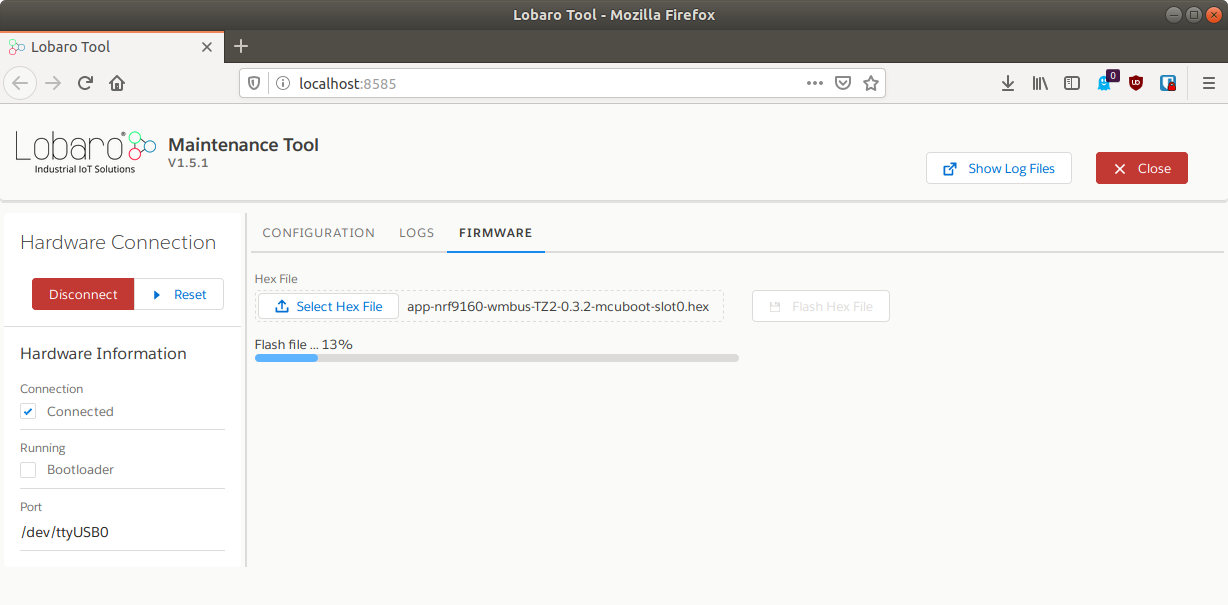
Make sure your Device is successfully attached to the your computer and the Maintenance Tool is connected, as described above. In the Tab FIRMWARE you can select the Firmware file you want to install using the button Select Hex File. This will open a file selection dialog, where you can select the hex-file with the Firmware you want to install to your Device. To start installing you need to press Flash Hex File. The upload will take several seconds; progress will be displayed by the blue progress bar. It turns green on successful completion. You can verify the installation succeeded and your Device is now running the correct version by checking the LOGS Tab.
You should also take a look at the Configuration Parameters. When an update adds new features, there might be new Configuration Parameters to set, or some existing Parameters might work differently. Check the Firmware's Changelog to see what changed between versions and what you have to look out for, for your individual Firmware update.
Changelog
- No labels